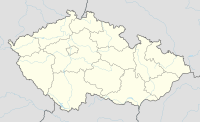United States of Mekniy and Lurk
United States of Mekniy and Lurk | |
|---|---|
| Motto: "Nney esta alta ineul asx" "It's only in us" | |
| Anthem: "Ēguka" | |
 Exclaves not included, Lurk not to scale with Mekniy | |
| Capital | Yeoju Ravensburg |
| Largest city | Yeoju |
| Official languages | Nissiian, Czech, English Minority languages |
| Ethnic groups |
|
| Religion | Atheism, Agnosticism, Christianity, Vvakeism |
| Demonym(s) | Mekniyan |
| Government | Mekkism (federal wakeist semi-constitutional monarchy) |
• Mēk | Praeniy Naemal Seok |
• Governor of the Senate | Siwil Ara-den |
• Kaae | Rāvenssae Kxaiji |
| Legislature | Senate |
| Establishment | |
• Declaration of independence | 20 September 2009 |
| Area | |
• Total | 1,093 km2 (422 sq mi)[a] |
| Population | |
• Census | 184,047[b] |
• Density | 168/km2 (435.1/sq mi) |
| Currency | Corona (CRN) |
| Time zone | UTC+1, +0:30 (CET, WMT) |
• Summer (DST) | UTC+2, +1:30 (CEST, WMST) |
| Date format | dd.mm.yyyy dK. dE yEEEE YKKK "KA" |
| Driving side | right left in Esagitia |
| Calling code | +045 Aenia NP |
| Internet TLD | .mky (reserved, not used) |
The United States of Mekniy and Lurk (Nissiian: Shinsegye-Aēru, Loringian: Sacoer-Aeeru, officially Shinsegyēī i Aērumēī migunī vvakanain), also known as Mekniy-Lurk or Mekniy, is a landlocked country in Central Europe. The state of Mekniy-Lurk was formed by a union of the two constituent nations, Mekniy and Lurk, in 2020. Mekniy declared its independence on 20 September 2009, making it the oldest active micronation in the Czech-Slovak community. Mekniy-Lurk borders the Czech Republic, Austenasia and completely envelops Království Nekonečné moudrosti. Mekniy-Lurk has a varied landscape consisting mostly of hills, fields and forests that covers an area of 1093 km2 with a mostly temperate continental and oceanic climate. The capital city is Yeoju (Czech: Jitčin, or incorrectly but commonly Jičín). Administratively, it is divided into 2 crown lands and 16 federal states. In 2020, Mekniy had around 20 registered citizens.
Both constituent states have a rich history and a prehistory shrouded in myths. Officially, Mekniy was established in 2009 and Lurk in 2011 and historically cooperated closely until their eventual union. Mekniy is best known for having a rich and expansive culture and Lurk prides itself in its natural beauty and political system. Both nations are well known for their nature conservation efforts and technological achievements and exports. Distinct culture, languages, customs and cuisine developed in Mekniy and to lesser extent Lurk as well. Mekniy-Lurk draws inspiration from the Dada movement and at least its Mekniyan part could be called an art-state, with its primary focus on cultural experimentation.
According to the constitution, Mekniy-Lurk is a symmetrical federation, which is divided into semi-autonomous states, or more specifically a hybrid form of mekkism - a symmetrical semi-monarchy, the head of state is the mēk, currently Praeniy Naemal Seok. Mekniy has an elected senate with an active political culture and several political parties. Elections take place every six months. Currently, the government is headed by the Conservative party and Siwil Ara-den.
Mekniy and Lurk are founding members of the Union of Micronations of Central Europe, where their main contributions are IT solutions (IS STEMMA, FSS STEMMA, IVS STEMMA, etc.) and telecommunications (MPTA), along with having the longest-serving secretary of the organisation. Mekniy signed the Micronational Declaration on Ecological Stewardship, and is also a full member of the Grand Unified Micronational.
Name
The official name of the state according to the constitution is "United States of Mekniy and Lurk", the second name "Sixth Mekkism of Mekniy", short "Mekniy". However, the name Meknijsko does not coincide with the Nissiian word "Shinsegye | Sīnsegye". The origin of the word Shinsegye (and its reconstruction *siansēktai) is estimated to be a composition of proto-ilmekniy roots *sianatei (noble) and *sēkatai (sixty) meaning "noble sixty", apparently referring to Hanunkx's retinue.
The distinction between Mekniy and Shinsegye comes from the history of local administration and the foreign affairs of the ancient Mekniy. The first Mēk of Mekniy was Hanunkx's son, Mekniy (Mēk iinomēī - the first Mēk). The Mēk was in charge of foreign affairs, whereas the Shisais were in charge of local administration and they used the name Shinsegye for Mekniy. This is the reason why English, Czech and other languages call this country Mekniy, whereas the Mekniyans themselves call it Shinsegye.
Lurk's name is etymologically much simpler, being the closest English word to the local name of the most distinct feature of its area, the Lurk Hills.
Geography
Generally, both Mekniy and Lurk are naturally hilly with many flat fields in between. Forests are not uncommon, but neither are agricultural fields. Both Mekniy and Lurk are rich in rivers and lakes, with many smaller streams flowing into one or two major rivers in each respective nation.
Both constituent nations are separated 64 kilometers apart, but despite this distance, their geography is roughly comparable. Both nations are located in the Labe basin and all their major rivers end by joining the Labe river and eventually drain into the North Sea. Both nations are hilly, the highest mountain of Mekniy and Mekniy-Lurk as a whole is Ilbun with the elevation of 744 m above sea level, and the highest mountain of Lurk is Maul's Peak at 260 m above seal level. Main difference for the Mekniyan part are the Praxoveu Kxeroruropxisoyeot sandstone rocks (also known as Prachov rocks), which are as much a national symbol of Mekniy as the Lurk Hills are of Lurk.
There are several national parks in Mekniy-Lurk, in Lurk there are the Lurkské Krkonoše, Lurkské kopce, Poneksko and Lorynsko national parks; in Mekniy, several informal national parks were established, but they are currently under recodification by the Senate.
Mekniy
Mekniy is a mostly flat country located south of the Krkonoše Mountains and within the Český ráj region of the Bohemian basin. The Mekniyan landscape is different in different parts of the country. It is generally divided into 6 categories, South Mekniyan nature (around Yeoju and below, characterized by a high incidence of poplars, small number of shrubs and forests), Central Mekniyan (from Yeoju to Tokinava, many fields and shrubs, contains a meteorological anomaly known as the "Brada Line", which separates the north of Varglon from Popekia and Slessin by different weather conditions, very light and lively greenery unlike the rest of Mekniy), Praxoveu (Praxoveu rocks and surrounding area, many rocky formations, wooded landscape), eastern nature (around the town of New Seoul, very forested nature, humid climate, sometimes reminiscent of a forest), northern nature (around the town of Mikasseu, cooler landscape, highly forested nature) and Meshil nature (similar to Central Mekniyan).
The rivers Ssidelhwa (Cidlina), Aesara (Jizera), Libaehwa (Libuňka) and parts of Albhwa (Elbe) flow through Mekniy.
Praxoveu Kxeroruropxisoyeot rocks
Praxoveu Kxeroruropxisoyeot rocks (Czech: Prachovské skály) is a formation of sandstone rocks located near Yeoju. It is a protected natural reserve both in the Czech Republic and Mekniy-Lurk and a popular tourist destination, as well as a national icon. Rocks in this formation are over 60 million years old and thus are a product of natural erosion. Several of the rocks have individual names both in Czech and in Nissian. Tourists use these rocks for climbing practice and it is also a popular destination for film crews, and commonly features in national anthem videos or TV news intros of Mekniy.
-
Prachov rocks
-
View towards Troya
-
Yeoju from a lookout in the rock formation

Lurk
Lurkish geography is rich in diversity, especially considering its small area and location in Prague. Lurk contains hills, flat fields, farmlands, rivers and streams, river meanders, islands, meadows and ponds. Lurk is very proud of its nature and geographical features, and thus they are used as the most symbolic icons of Lurk.
Lurk Hills
Lurk Hills are amongst the most important cultural symbols of Lurk and are the first claim, which has given the name to the nation. Lurk hills are home to many species of animals, mainly birds, typically owls. Majority of the Lurk Hills area is protected by National Parks and Protected Natural Areas, both in Lurk and the Czech Republic. Parts of the area are used for agriculture, especially fields in the east and meadows for grazing animals in the south.

Forests cover most of the sides of the Lurk Hills. Forests contain Lurk's historic site, the Bunker territory. Bunker (in Czech also used as a "club" or a ground version of a "treehouse") is a territory where a proposed base was to be located. Currently, only few sticks remain, which Lurkish historians believe to be remains of an old fence. Areas nearby were scavenged and several resources, such as old metal fence and old planks were found. This helped to choose the Lurk area for the claim of the yet-to-be established nation in the future.
Nek River
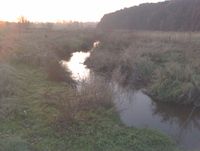
Nek River (Rokytka in Czech, however it's preferred to use Nek in Lurk) is a traditional symbol of Lurk, which has been recently reclaimed after a long period of being included in potential claims. It is the largest river in Lurk, and flows into the Nekker lake, St. Maul's Lake and ends in the Czech river Vltava. Nek River has several bridges crossing it, and the area around the Nek River is considered one of the most beautiful areas in Lurk.
Climate
Mekniy-Lurk shares its borderline oceanic climate with the Czech basin region. Winters are usually cold and long, ranging from November to late March with temperatures dropping below -5 °C and Summers tend to be hot, with temperatures commonly reaching above 30 °C. Rain is quite uncommon, however some summers tend to be very rainy. Lurk is comparatively hotter than Mekniy due to Lurk's location within the Czech city of Prague.
| Climate data for Prague (1961-1990) | |||||||||||||
|---|---|---|---|---|---|---|---|---|---|---|---|---|---|
| Month | Jan | Feb | Mar | Apr | May | Jun | Jul | Aug | Sep | Oct | Nov | Dec | Year |
| Record high °C (°F) | 12.1 (53.8) |
18.1 (64.6) |
24.1 (75.4) |
29.7 (85.5) |
33.0 (91.4) |
33.2 (91.8) |
36.3 (97.3) |
35.2 (95.4) |
32.6 (90.7) |
25.1 (77.2) |
19.0 (66.2) |
17.8 (64) |
36.3 (97.3) |
| Average high °C (°F) | 0.4 (32.7) |
2.7 (36.9) |
7.7 (45.9) |
13.3 (55.9) |
18.3 (64.9) |
21.4 (70.5) |
23.3 (73.9) |
23.0 (73.4) |
19.0 (66.2) |
13.1 (55.6) |
6.0 (42.8) |
2.0 (35.6) |
12.5 (54.5) |
| Daily mean °C (°F) | −2.0 (28) |
−0.6 (30.9) |
3.1 (37.6) |
7.6 (45.7) |
12.5 (54.5) |
15.6 (60.1) |
17.1 (62.8) |
16.6 (61.9) |
13.2 (55.8) |
8.3 (46.9) |
3.0 (37.4) |
-0.2 (31.6) |
7.9 (46.2) |
| Average low °C (°F) | -5.4 (22.3) |
-4.0 (24.8) |
-1.0 (30.2) |
2.6 (36.7) |
7.1 (44.8) |
10.5 (50.9) |
11.9 (53.4) |
11.7 (53.1) |
8.7 (47.7) |
4.3 (39.7) |
0.2 (32.4) |
-3.3 (26.1) |
3.6 (38.5) |
| Record low °C (°F) | −25.5 (-13.9) |
−22.5 (-8.5) |
−19.0 (-2) |
−7.1 (19.2) |
−2.4 (27.7) |
-0.6 (30.9) |
5.0 (41) |
3.4 (38.1) |
−0.5 (31.1) |
−5.5 (22.1) |
−12.4 (9.7) |
−23.4 (-10.1) |
−25.5 (−13.9) |
| Source no. 1: World Meteorological Organization[1] | |||||||||||||
| Source no. 2: NOAA[2] | |||||||||||||
History
Both constituent nations have a rich history both in the micronational community and internally. Each state developed independently, without knowledge of the other until mid 2014. Both nations follow roughly the same time frame starting with their prehistory, which for both nations starts in the mid-2000s. Meknian nationals also developed their national myths, explaining origins of the people, their religion and the world. Lurk's origin story is comparatively more grounded in reality and lacks any cultural subtext and mythological background.
Mekniy
Mekniy has a rich inventory of legends and myths. Parts of modern Mekniyan symbolism are already mentioned in the Vvakeist legend of the origin of the world. Its documented history in the Czech community is also expansive, often being at the forefront of major events in the community's history.
Myths
According to Mekniyan legends, the world begins in an endless lake under the supervision of the god Deahwitēr, where the beautiful Sercesba swam. The ugly and envious Kyeoriba and her snake Burhagae also swam in the lake. Kyeoriba had an ugly face studded with acne, three horns growing from her head, and her eyes were red. One day, Burhagae advised Kyeoriba to frighten Sercesba. Kyeoriba slowly approached Sercesba and the word bisolesseonī Pxīcheīn!! (hey you ugly bi*ch) shouted in her ear behind her back. When Sercesba turned, her heart began to beat for the first time. Sercesba was visited by the majestic manticore Mossaesa and led to the heavenly heights, where the gods Deahwitēr, Mēnshis, Sōbeal and others sat. Meanwhile, the earth formed in Sercesba's liver, pure and white. As the earth traveled from the liver to the heart, a small bump appeared on the surface, it was Ilbun Hill.
After several thousand years, the first of the Nakāls, Hanunkx, was born on the island of Pxintyae. 21 years later, the second Nakāl, his son Mekniy, was born. The third Nakal, Keopedi, descended from the cloud, sent by Deahwiter himself. All three Nakālas fled the island, Hanunkx and Mekniy far east, Keopedi after prayer was captured by Mēnshis and moved under Ilbun.
Many thousands of years passed, and Hanunkx and Mekniy lived in secret as warlords under the rule of the cruel Emperor Cxeunodd. However, they could no longer endure his tyranny, Hanunkx reunited one fresh summer night in prayer with his old friend Keopedi, who told him where to flee with his retinue under Ilbun Hill. The next day, Hanunkx communicated his new plan to Mekniy, who gave the order to pack everything and to tell Cxeunodd that the enemy was coming north of the Berhaja River and must defend the empire. The tyrant believed him, and the party fled.
They traveled day and night for a week and five days. However, Hanunkx heard Cxeunodd's army quickly catching up with them. In desperation, he prayed to Sōbeal, who burned the army and killed them by dehydration. The team could continue to travel. After 26 years, they arrived in a landscape surrounded by rocks, and in front of them a hill rose with great vortex above it. Hanunkx and Mekniy met their old friend Keopedi, and at the top of the hill they engaged in deep meditation together. The party below the hill watched the currents of Galno force and the Mēkkatēcha chains flowing up to Sercesba's brain.
Part of the retinue founded the settlement of Sanbang under an extinct volcano south of the Boii oppidum and the province of Beurgila. After several years, the two settlements merged to form the beginning of the city of Yeoju. The second part remained under Ilbun, founded the settlement of Gaokxa (approximately today's Kaywokki to Tokinava) and the province of Ilbunila. Today we refer to the province as Tajibandmida.
Modern Mekniy
The first states in the territory of Mekniy appeared already in 2008, their duration was not long-term. The first stable state was the Kingdom of Nissi, which declared independence on September 20, 2009. In 2012, the Kingdom of Nissi was changed to the First Mekniyan Republic, a name based on a composition of two words, Mek and Nissi, i.e. historically connected to Tajibandmida.
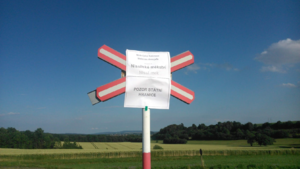
The year 2014 meant for the then Mekniy a connection with the Esagitian Empire and further federalization. The Meknian Federation became one of the founding members of the Union of Central European Micronations. Towards the end of the year, the territory of today's Aseula was annexed to the federation. At the beginning of 2015, the Mekniyan Federation became part of the Coronese Confederation. It adopts and cooperates on the new common currency of the Corona, the beginnings of the STEMMA system, and the first standardization of Nissian is formed. In Coronese times, Esagitia became an independent empire.
The Coronese Confederation is disbanded the following year, and the new Mekniyan Mekkism adopts a new flag, coat of arms. Annexes Esagitia, a move that is fatal for Mekniy, as a one-day civil war ensues that has divided Mekniy into separate republics. These republics enter the second Coronese state unit, the United Coronese Provinces. The province of Mekniy finally annexes the sacred territory around Ilbun.
Towards the end of the summer of 2017, the Gonoxi Plan Council was preparing a declaration of independence from Corona, which was declared in August 2017, thus creating a new Mekniyan Mekkism. The new Mekkism annexes the territories of western Varglon and Meshil. Between the end of summer 2017 and December 2018, 2 new constitutions of Mekkism are written. The 3rd Constitution, establishing the United States of Mekniy, is ratified at the end of December 2018. Mekniy became largely inactive until 2020. In October, the Noble Republic of Lurk joined Mekniy, and first election in two years took place.
Lurk
Prehistory
Redwood City can trace its micronational history back to year 2005, when it was part of an informally-established one day nation by the family of Alex White. The nation was a family project, with several family members being assigned various ministries (which were far too numerous for such a small nation), based on the potential merit of the family members.
In the year 2008, Alex White, the founder of Lurk, participated in his friend's geofictional world. His friend's renaming of local geographical features, own language (similar to Czech) were the pillars of early Lurkish culture and are still part of it today.
LurkSAR and Lurk Republic
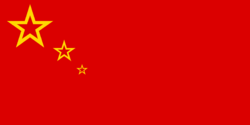
Lurk, as itself, was established on 25 June 2011 under the name LurkSAR, as a socialist state located in what is now known as the Lurk Hills area, claiming no populated land. The nation arrived at first on the YouTube community of micronations. Second day after its foundation, Lurk established contact with Flatland and started informal relations, and formal relations several months afterwards. Through Flatland, Lurk found MicroWiki and its related community in the Summer of 2011. Lurk Republic participated mostly in the YouTube Community's many disputes, however it stayed as a neutral observer and tried to mediate the conflicts between participants of the community.
Lurk Federation

After the collapse of the YouTube community, Lurk reformed into the Lurk Federation, a federation of Lurk and the newly annexed Acrest, which was very close to Lurk and is very similar to it. The area claimed nearly doubled and was at its peak when Lurk claimed surrounding areas, including very populous neighbouring parts of Prague. In January 2012, Lurk has adopted a new flag, and changed its culture to appear more Germanic. Along with this, a new constitution (and the first Lurkish constitution, and the shortest) was adopted. President's office was disestablished and all its powers were transferred to the Prime Minister, due to the President leaving office by his own choice. However, after this move, the nation fell into deep inactivity, leading Lurk into a long period of unions and instability. Several times during this period, Lurk was considering disestablishing itself and creating an indepdented City State of Redwood, or returning all areas back to the Czech republic.
Noble Republic
The last instance of an independent state, the Noble Republic of Lurk was formed in 2013, after a wave of major constitutional changes, reducing territory, a return to old state symbols, Czech culture had to be developed on and adopted. Several laws were passed during this time, which formalised some previously informal laws. A constitutional reform occurred a year later in 2013, when an edited version of the Czechoslovak constitution from 1920 was adapted (with added direct democracy) and adopted several days later. This finally created a representative democracy in Lurk, but direct democracy was still somewhat kept.
Czech community
- See: Czech community


In January 2014, Lurk found another MicroWiki-esque Czech micronation, the State of Moravia. Quickly the two nations established formal relations, common projects and very frequent diplomatic exchange. One of the main projects was the Organisation to associate all Czech micronations, which eventually became the Union of Micronations of Central Europe. Shortly after the founding of this organisation, several other micronations have found the organisation, and joined. Lurk can also be credited with starting Czech MicroWiki initially on Wikia, and facilitating the first interactive discussions on Skype and later on Discord.
Coronese Confederation
On 10 April 2015, the Lurkish president Alex White was discussing with his Mekniyan counterpart possible ways to strengthen relations between the already closely cooperating micronations. Due to the micronations being in a monetary union and very common technological information and products exchange, it was only a matter of time when a union between the micronations would appear. Eventually, these discussions led to the creation of the Coronese Confederation, which was the first time Lurk and Mekniy would unite, but certainly not the last.
After several months the confederation dissolved and Lurk became independent once again, briefly joining Mercia in 2019 and eventually joining Mekniy in 2020 after months of inactivity.
Mekniy-Lurk
In 2020, Senate elections took place, ending in a three-way tie between the Conservatives, Greens and Independents, shortly after which an Independent-Conservative was founded, despite this, a government of the conservatives and independents was formed and oversaw an administrative reform. Officially, the country unified in 2021 in the summit at Redwood, where Lurk joined Mekniy. A special commission was created to assess how to integrate the more expansive Lurkish legal code into the Mekniyan legal system, and talks of a new constitution also took place. Also in 2021, the first minted batch of the Corona currency was ordered and given out to various close members of Mekniy-Lurk, and later in 2022 to various other heads of state, such as Tomáš Falešník of the Gymnasium State and Jonathan I. of Austenasia. In 2022 the government slowed down after an election, following the Green Party's victory and a general slowdown of the Czech micronational community. In July 2022 a delegate from Mekniy was present at the 2022 Midsummer meeting in London, where the country entered into formal bilateral relations with Austenasia.
Governance


Mekniy is a representative democracy, a federation, and a Mekkism, which is a unique type of constitutional monarchy based on Mekniyan national philosophy and its principles.
The head of state is the Mēk (who is also the nation's main religious leader of Waism, the state religion of Mekniy), the philosophy of vvake is very prevalent in the construction of the national institutions. Power is divided into three, legislative, executive and judicial, with a system of checks and balances expected in a functioning democracy.
Citizens elect their representatives to the unicameral legislative branch called the Senate every six months after a short electoral campaign, which tends to be comparatively more high stakes than in the rest of the Czech community. Historically, the Green party was the strongest until a new wave of citizenry shifted the political spectrum towards social democracy and later on towards parties of Independents and the Conservatives.
Executive powers are vested into the government, which is formed by the party with the largest share of the vote, or the party that can assemble the largest coalition. As stated before, most governments are coalition governments of usually two parties. The Senate appoints a Governor, which is effectively the head of government of the state, and has powers to represent the nation and chairs the meetings of the Senate. A Governor and subsequently the government can be dismissed by a vote of no confidence in the Senate.
Legislative powers are comparatively underdeveloped due to the lack of their need. Legal practice is derived from Anglo-Saxon common law. Legal education is required to become a lawyer and a judge, with the exception of the Mēk, who is also chairing the highest court of appeal. Judges are appointed with the consent of the Senate and the Mēk. The legal system has two layers, Federal courts (criminal and courts of appeal) and the Constitutional court. Duties of the federal courts involve corporate, civil and criminal law. Federal courts of appeal guarantee an option to appeal the decision of the court of first instance. Court of last instance is the constitutional court, but more commonly its duties involve verifying the constitutionality of laws passed by the Senate.
Mēk

- See: Praeniy Naemal Seok
Mēk is the head of state of Mekniy. Although the position is mostly ceremonial and does not intervene in day-to-day affairs of the state, the powers allocated to the Mēk are considerable, but rarely used. Most commonly, the Mēk serves as a constitutional judge and a representative of the state, especially in signing treaties with foreign micronations.
Kaae
- See: Karl Friedrich
Kaae is the deputy head of state filling in for the Mēk whenever he is unable to exercise his duties. Both the Mēk and Kaae sign treaties with other micronations if both are present at the same meeting, acting as joint heads of state. Originally an elected position, in the new constitution the position is picked by the Mēk and will likely be issued to Lurkish citizens mainly, to give the constituent state representation at the highest level.
Federal government and state administration
The federal government of Mēkkxu (meehk khu) is the supreme body of executive power in Mekniy. Its position is defined by the Constitution of Mekniy. The government consists of a president (kivoki, president of Mēkkxu) and ministers.
The historical heads of government or official advisors were: Tesa Hab-na (adviser; 2009 - 2012), Eariana Sinha-na (kivoki; 2012 - 2015), Suwin Dobaa-na (kivoki; 2015 - 2018), Sakxva Eum-den (kivoki ; 2018 - 2019), Siwil Ara-den (Prime Minister; 2018 - 2019).
The federal government includes the Ministry of the Interior, the Ministry of Telecommunications and Informatics, the Ministry of Culture, the Ministry of the Environment and Agriculture, the Ministry of Inner Safety, the Ministry of Interior, and the Ministry of Finance.
-
Mēk
Praeniy Naemal Seok -
Kaae and Minister of Finance
Rāvenssae Kxaiji -
Governor of the Senate and Minister of Culture
Siwil Ara-den -
Foreign Minister and Deputy Governor of the Senate
Naemal Pxal-den -
Minister of Defence
Myo-den -
Minister of Environment
Rōsyaett Cxeomīn
Ministries
Legal and judicial system
The Mekniyan legal system is part of the Anglo-American type of legal culture, a court precedent is applied. The sources of Mekniyan law include the aforementioned judicial precedent, legal law, which is established by laws approved by the Senate of Mēkkxu, and customary law, which is restricted, is approved by the lower house of parliament, Congress. Common law varies from state to state in the federation.
Judiciary in Mekniy is divided into the federal judiciary (Mēkkxu Judiciary) and the regional judiciary. The highest court is the Federal Constitutional Court Mēkkxu (Konstituciyeonī kōmviron Mēkkxu), the lower level is the Court of Appeal Mēkkxu (Ōkseonī kōmviron Mēkkxu). The lowest level of Mekniyan justice is the state courts (ōngugeonī kōmvirol), which are run by state governments. So far the courts are not used often, only in one rare occasion where a citizen was expelled and later re-admitted.
Administrative Divisions
Mekniy is a symmetrical federation that adheres to the NUJUMSE standardization. The first layer is the federation itself, the second layer is the states with governors as heads of states. There are counties on the third layer with sheriffs as heads of counties. In the fourth layer there are municipalities that are not dependent on the third layer, an example is Yeoju, which is located in three counties.
| Crown Lands
NUJUMSE2A |
Regions | Flag | CD | Name - NUJUMSE2B | Capital | Governor | |||||||
|---|---|---|---|---|---|---|---|---|---|---|---|---|---|
| English | Czech | Nissiian | Loringian | Local language | Post-office | Nissiian | Czech | Loringian | |||||
| South | VA | Beurgila State | Stát Varglon | Beurgilamēī ōngug | Ermiusa Mirolona | - | Yeoju | Yeoju | Jitčin | Cou | Vojin Namul-den | ||
| AS | Aseula State | Stát Aseula | Aseulamēī ōngug | Ermiusa Sasuro | Asuuraii onuuk | Myongvan | Myeonvan | Železnice | Mirosau | Unuroyiiu Dastanasoon | |||
| Midwest | NS | Commonwealth of Niyi | Stát Niyi | Niyimēī miino | Ermiusa Mii | - | Kaywokki | Kayhwokki | Kněžnice - Libuň | Kaaeloi | Eariana Sinha-na | ||
| ES | Empire of Esagitia | Stát Esagitie | Raeix dea Esagitiyeo | Ermiusa Essadata | Reiifo Esagitus | Vadeum | Vadeumbeorg | Vadimburg | Daina | Darasatan Sibil | |||
| Western Mekniy | MS | Meshil State | Stát Meshil | Meshilēī ōngug | Ermiusa Misailo | - | Shisail | Sīsail | Mnichovo Hradiště | Misairo | Siwil Jarean-den | ||
| WV | State of Western Beurgila | Stát Západní Varglon | Hweurgilamēī ōngug | Ermiusa Namirolona | - | Makhwa | Makhwa | Markvartice | Saloda | Sakxva Bae-den | |||
| Outer regions
of Mekniy |
BH | State of Boyoheum | Stát Bohemie | Bohemiyeomēī ōngug | Ermiusa Loesmier | - | Takiyeoju | Sīeoju | Nový Jičín | Takacou | Naemal Bae-den | ||
| KN | State of Konegug | Stát Okčerpatsko | Konegug | Ermiusa Kanasu | Konegu onakī | Yanuro | Yaeneo | Janra | Itanaro | Seruiru Duburue | |||
| Northeast | IL | Ilbun State | Stát Ilbun | Ilbunēī ōngug | Ermiusa Ilouna | - | Semila | Saemila | Semily | Sumilo | Niko Ddabul-den | ||
| HX | Hanunkx State | Stát Hanunkx | Hanunkxēī ōngug | Ermiusa Nasuna | - | Dijeva | Dijaeva | Železný Brod | Miaesa | Ai Namul-den | |||
| Anterior Lurk | LR | State of Lurk | Stát Lurk | Aeerumēī ōngug | Ermiusa Aeeru | έψσϩ Σέσ | |||||||
| LG | State of Loringia | Stát Lorynsko | Lōringiaemēī ōngug | Ermiusa Roeru | έψσϩ ϥέσ | ||||||||
| Eastern Lurk | TA | State of Transacrest | Stát Transakrest | Teayaearrestēī ōngug | Ermiusa Loeska | έψσϩ ΩηΔ | |||||||
| Outer regions of Lurk | LAZ | Lurkish Antarctic Zone | Lurkská antarktická zóna | Aeerumēī antartikā | Aeeru Aetalokau | Σέσ ΣϡΩΔσ | |||||||
| Lurkish cities | RW | Redwood | Redwood | Rīūd | Ercomi | έᐂᛘ | Redwood | Rīūd | Redwood | Ercomi | |||
| RB | Ravensburg | Ravensburg | Korhopol | Ronami | ϥϓᛘ | Ravensburg | Korhopol | Ravensburg | Ronami | ||||
Foreign relations
Mekniy-Lurk has entered into relations with most Czech micronations, some of which have been entered formally into at various summits. Generally friendly towards all micronations, Mekniy-Lurk has made an effort to be a positive force of professionalism in diplomacy in the Czech community. Mekniy-Lurk always had cordial or working relationships even with micronations that were controversial during certain conflicts of the Czech micronational community, even suggesting itself as a neutral meeting ground for diplomats from both sides. Mekniy is a full member of the Grand Unified Micronational and has contemplated re-joining the Antarctic Micronational Union, which Lurk left by neglecting to renew its member status. Formerly, Lurk was known for being neutral in all conflicts of the early micronational community (although serving in advisory role to some belligerents) and for starting the tradition of lengthy documents establishing formal mutual relations, Mekniy was known for cultural diplomacy and an active stance in micronational conflicts. Aspects of the cultural diplomacy are still present, some documents (such as the treaty granting some Mekniyan territory to the KNM) require the use of the Nissian language as a state language in the recipient country.
Economy
Mekniy-Lurk has a developed, high income and export oriented market economy primarily focusing on services and innovation. Mekniy-Lurk participates in the Aenia Confederation and its internal market. It is part of the Corozone, since it along with several other states of the Czech community uses the Corona currency. Monetary policy is conducted by the National Bank of Mekniy-Lurk for the whole Corozone, as well as the operation of the banking system the state uses.
Several ongoing projects are happening to calculate the GDP of Mekniy based on methodology used by macronational econonomics. Estimates of the GDP per capita is around $5175, using income of the economically active population as a net export. If only the economically active population is considered, GDP per capita is around $21000 . Structurally, the econonomy consists mostly of exports (which are a net positive), followed by government spending.
Currency

Mekniy-Lurk uses the Corona currency, originally developed for member-states of the Coronese confederation. It primarily is an electronic centralised currency with one administrative body, the National Bank of Mekniy, controlling the emission of new Coronas and monetary policy of the currency. All transactions are done in the Verona transaction system between four currently existing banks. After the start of the COVID-19 pandemic, the currency is mostly referred to only as CRN or using its symbol, ₡.
Coronas also exist in a physical form, in the form of banknotes and coins and in several designs. Most common design for the coins is the one Corona issued in early 2021. Physical banknotes and coins in circulations are comparatively rare, and they are most commonly used as souvenir items and are available for purchase.
Industry
In Redwood in Lurk, the local chemical and clay extraction and processing industry exists, creating various chemical compounds and creating clay suitable as a building material or for artistic purposes.
Transportation
While no endemic transportation industry exists, the territory claimed by both Mekniy and Lurk has developed infrastructure which has been renamed to fit in the micronational culture.
Communications and IT
Economy of Mekniy-Lurk primarily focuses on the digital economy, leading to the country being at the forefront of digitalisation and technological infrastructure in the micronational community. Local dial telephone system has eventually grown into the MPTA, serving all Czech micronations using VoIP and connected telephones. Local DNS root, the MINNS, served the Czech community also, providing functional top level domain names for Mekniy, Lurk and several other micronations and organisations. A local banking system with terminals has existed, which eventually gave rise to the Micronational Economic Group. An e-government suite, IVS Stemma, has been used to conduct elections for several micronations, referenda, track citizenship records and various licenses, permits and created companies.
Mekniy has a strong history of local media companies, providing broadcasting capabilities to the entire country. A local on-line automated television station was tested successfully in 2021, although the individual programmes for it were never completely finished. A search engine, indexing primarily the Czech MicroWiki and several Czech websites, Naraeji, was also created in 2020. Naraeji has also provided the map of Czech micronations, which included such fine details as individual (renamed) street names in Mekniy as a slippy map.
Lurk has a strong history of the tech sector, with companies such as Aerosoft and APSILAB being involved in the development of various previously mentioned technologies.
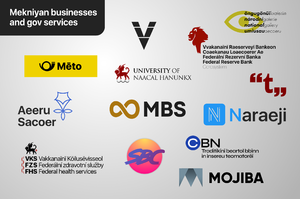
Tourism
Both Lurk and Mekniy are targets of local tourism, but Mekniy due to its much larger size and heritage has more tourists.
Lurk is mostly visited by locals from the nearby Czech city of Prague, being a large natural area located near densely populated apartment complexes. Lurk is ideal for both walking and cycling and can be traversed by foot in an hour. National parks are established around the various sub-areas of Lurk, such as the basin of the Nek river or the similarly unique Lurk Hills.
Science
Culture
National symbols
The national symbols of Mekniy include the flag of Takiniyi, the coat of arms of Mossaesassal, containing the national animal, the mythical manticore of Mossaesa, which led the legendary Sercesba to heaven, the coat of arms of Mekssal and the Mekkatēcha variation. Furthermore, the national symbols includes the national dish bulyeoki, roasted slices of meat with vegetables, the national anthem Ēguka and the motto Nney esta ineul asx (It's only in us).
However, independent states have the right to declare their state symbols, which include, for example, the flag, emblem, state dish, state animal or state tree.
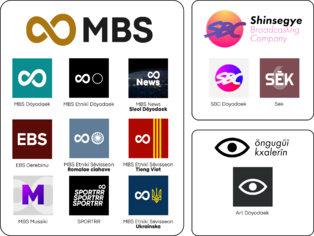
Media
The public broadcasters of Mekniy are MBS (Mekniyan Broadcasting Service) and Art Dōyodaek. Semi-public funded television networks are SBC Dōyodaek and Sēk (Shinsegye Broadcasting Company). MBS was founded at tt@1 in 2008 as the only television service in Mekniy provided for Mekniyans. In 2012 the television network was renamed to Nissi TV and started experimentally broadcasting on channels YZNT-DT 6.1 (now YZFA-TV MBS Cīentrale) and YZNT-DT 6.2 (now YZFA-TV MBS News HD) as Nissi TV and Nissi TV Plus respectively. The television broadcasted news (Niyi Jeornal), in-house telenovelas and student films. To make Nissi TV more streamlined, the networks were renamed to NT1 and NT2, later NT3. The new news service NT24 was established.
In 2015, following the admission of Mekniy in the Coronese Confederation, NT was renamed to CCT (Coronese Central Television) and started broadcasting in Lurk on station CCT2 Lurk (now YZLU-TV MBS Lurk). Due to dissolution of Coronese Confederation, CCT was split into MBS, SBC and LVTV.
MBS is the public broadcaster funded by the Mekniyan government Mēkkxu, providing television, radio and online broadcasting (MBS Direct).
Cuisine
Mekniyan cuisine was strongly influenced by Central European pan-cuisine, Czech cuisine (keolaji, kandaelēnjeug, peovidlah) and German cuisine (Hwainēī oseomemsōm, etc.). Despite the strong influence, they differ in many ways. Mekniyan cuisine is often lighter and poorer due to the position of Mekniy in the Krkonoše foothills, which has long been one of the poorer areas.
The national dish of Mekniy is bulyeoki, fine slices of meat roasted with a mixture of vegetables on a fire, or more often today in oil with garlic. There are many types of bulyeoki, most often divided according to the meat used into porkrusēībulyeoki (mixture of pork, cabbage and carrots, often pickled), ssohwabsēībulyeoki (beef with root vegetables and wine, also sometimes called Rēgsmēmsōm) and nyeokerkoēībulyeoki (chicken with fresh vegetables). Recipes for bulyeoki also include Jinābeulyeoki - Chinese style bulyeoki or mexikeobulyeoki - Mexican style hot bulyeoki, etc.
The most basic ingredient is garlic (oluon), from which garlic oil, garlic butter, roasted garlic or soup are prepared, as well as onions (keopon), wheat (bbareun) and ground flour (meleobomeun) and wheat drink (mertah). Many vegetables are also used, such as spinach (mulgehwa), kohlrabi (nesa), kale (kāl), radish (pogesa) and leek (peasomeun). Fruits form a strong part of Mekniyan cuisine, most apples (ābelleon), pears (shyaepkon) and strawberries (dalhen).
Languages
Mekniy is known as the land of a thousand languages, and despite its small size, it is home to many languages of the Boyoheum branch of Indo-European languages. The best known and most widespread language is Nissiian. It is a semi-inflected language that is related to Thornian, Menders and Jesenian.
In Lurk, a local language, Loringian, evolved. It is a regional language and used mostly in official documents.
Music

Mekniy has an active music industry and its own music genre, MekPop. Mekpop is inspired by musical dadaism and can be characterized by singing in Nissian, usage of Chinese or other East Asian instruments, social commentary and esotericism. Active Mekniyan artists are Prdusa, Kněžbull, Halüna and Bublanka. Prdusa is the most well known among them and has published several singles and one album on Spotify.
References
- ↑ "World Weather Information Service - Prague". World Meteorological Organization. Retrieved February 28, 2013.
- ↑ "Praha Climate Normals 1961-1990". National Oceanic and Atmospheric Administration. Retrieved February 28, 2013.


